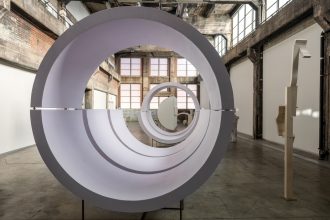In May I was part of a panel at NADA. It wasn’t about criticism but someone asked me why I write reviews of art fairs. The question caught me by surprise, given the setting, but I’d had that conversation before. I wondered about it too. I’d thought through the same concerns: a fair is not a place to look at art, it’s a marketplace; a fair is not curated; all fairs look alike, so the reviews about them will operate similarly, only swapping out the names of the artists or galleries.
At NADA, I gave a really simple answer: that an art critic can’t walk into a room (or tent) full of art and not respond to it somehow. A member of the audience then pointed out the historical link between criticism and the salons (namedropping Diderot at an art fair!). But my response might have been too facile. It eschews responsibility.
What’s the difference between Chelsea and an art fair? Almost all the reviews I write cover solo exhibitions or curated thematic group shows in commercial galleries. How is that so different from Art Basel’s sections, like Feature (“emphasiz[ing] precisely curated projects that may include solo presentations by an individual artist, or juxtapositions and thematic exhibits from artists representing a range of cultures, generations, and artistic approaches”) or Statements (“exciting new solo projects by young, emerging artists”)? The result of a substantial relationship between an artist and a gallery, the solo gallery exhibition can be a space for an artist to realize a project they couldn’t have at a nonprofit (which may not be able to support a given work, or has less of a commitment to the artist). The gallery is a space to test new work and ideas, but it may not be as different from the art fair as we want to believe.
When criticizing fairs as spaces meant for the sale – not the observation – of art, we focus on viewing conditions. Granted, looking at art is what an art critic does, but there has to be room for that discussion to include systematically writing about circulation and production, two things the art fair has changed to a great extent. In fact, a gallery exhibition may disguise the direct work-to-market relation by emphasizing viewing, by the sheer familiarity of the white cube. A fair presents it, and yet, it’s part of what we renounce when saying fairs are not places to really experience art.
Should we talk about money? The famous Ruskin-Whistler trial was the result of a question of economics, not artistic merit (well, quality was involved: Ruskin, in his review of an exhibition which included Whistler’s Nocturne in Black and Gold: The Falling Rocket, wrote, “I have seen, and heard, much of Cockney impudence before now; but never expected to hear a coxcomb ask two hundred guineas for flinging a pot of paint in the public’s face.” The criticism here is obviously one on aesthetics [“a pot of paint”] but its impetus is monetary: the charging of 200 guineas). Ruskin may have lost Whistler’s libel suit (he paid a token sum of one penny) but the result was a discussion (in court!) on the role of the critic and the relationship between artists and their critics.
Divorcing criticism from the economics of art doesn’t add up. It’s like separating the artwork from its market value: it presents a partial reflection of the art object’s circulation in the world. The market can embrace any practice so long as it sells, and – as we’ve seen with performance, installation, and video – all media can be saleable. I’m not calling for a Ruskinesque attitude in which work is assessed according to its market price, but rather, the opposite. One of the critic’s most important roles is to keep the market in check. In the context of an art fair, this doesn’t mean reporting sale prices (we can leave that to the many websites that blur criticism and journalism), but rather considering the market’s operation when looking at art.
I could write an essay about the state of painting in New York based on last May’s fairs season. It would mean thinking through what sells, what merits a spot in the $500-per-sqm booth, but also how the market determines what we get to see. Art fairs don’t just present what has a chance of selling, and they don’t only alter the way work circulates in the market. Sometimes they change the kind of work that gets produced. With the pressure to bring “new” work to a fair, artists find themselves producing pieces for their galleries and the fairs they attend. This production of market-driven work isn’t unique to fair demands (in the back room behind that ambitious video installation is oftentimes a pile of framed stills from that video), but it can be jarring to see the marketable work of artists who have recently had successful shows that didn’t necessarily include any framed pieces hanging on the wall.
Criticism, moreover, induces capital. I don’t want to overstate the importance of criticism, but a long bibliography can still be translated to a longer list of sales. Being cognizant of that is fundamental to a critic’s understanding of his/her role and the terms of engagement with the artworld. It’s not a matter of taste, really: in fact, when reflecting on the subject of subjectivity, I grapple with a statement by Guardian critic Adrian Searle, who, when asked about the issue of taste, shrugged it off, responding “taste is something you have to get over.” I’m not sure I agree, but to keep with the thought experiment, for criticism after taste, what is the task at hand? At an art fair, it’s not to weed out the “bad” from the “good” (I’m not getting into questions of quality), but to recognize the many quandaries surrounding the ethics and complexities of an art fair – for example, how to assess the curated sections and special projects. These important silos can’t be considered as exterior to the economics of the fair. Nor are their viewing conditions always different from those of the works displayed at booths. And then, how do we think about the talks programs as a space that builds context for – some would say, instills meaning onto – the works for sale? These are some of the issues that should drive our critical exhortation.
All these questions lead to one: Do we consider the fair a space in which contemporary art is presented only to those who can afford to buy it? We better not. Just as the gallery system is far from a perfect economic model, but is one that supports artists and discourse (this is my attempt at saying “this is the best we’ve come up with thus far”), so is an art fair part of the monetary system that defines the artworld. Artists, curators, critics, and dealers need to delineate – possibly constantly redraw – their respective relationships to the art market. We need to test the ethical waters with every step we take into the deep end of this economic system. Does participating at a fair’s talks program or curating a section of a fair make one complicit in any kind of way with this translation of cultural capital into dollars? Critics can’t afford to pretend the market does not exist. A critic’s role is to shape the conversation around it. If criticism doesn’t examine the systems of presentation, dissemination, and production of work, then what are we all still doing here?
























1 Comment